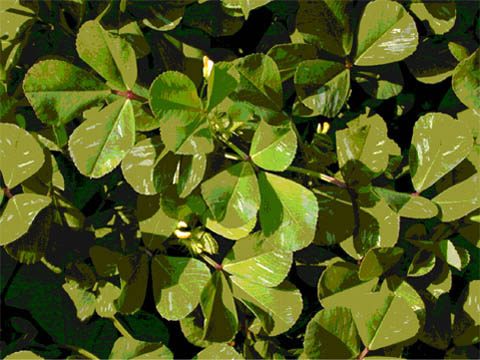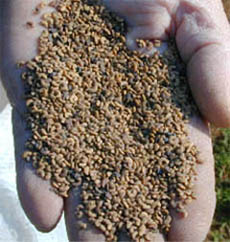
Murex medic
Murex medicMedicago murex Willd. - is a winter growing annual legume, adapted to growing on mildly acid to neutral soils where subterranean clover is normally grown. It remains prostrate when heavily grazed. If it is left ungrazed it will become erect and can be harvested for hay or silage.
The major advantage of murex over subterranean clover is its ability to stay green longer in spring and higher dry matter production in the first year. The high level of hard seed of murex medic makes it ideally suited as a pasture in short pasture-crop sequences, once a good seed bank has been established.

Origin
Murex is native to the Mediterranean region where it is found growing in association with subterranean clover on infertile acid soils in moderate to hard grazed situations. Collections of murex have been made in Greece, Italy and Sardinia.
Description
Growth habit ranges from prostrate to semierect. Leaves are dark blue green with small white flecks when young. Purple flecking may also occur on the leaf margins in winter. Leaves lose their flecking in spring and turn medium to bright green. Flowers are pale yellow, about 4mm long and similar in size and shape to barrel medics.
Seed pods vary in shape from oval to spherical and can be smooth or have small spines up to 2mm in length. Seeds are yellow-brown and weigh 3.5-5.5mg/seed. A single plant can produce both smooth and spiny pods on a single runner. Seeds are cream to pale yellow and similar in size and shape to barrel medics.
Uses
Murex can be grown as a regenerating pasture species in rotation with crops, with pasture phases ranging from one to four years. It will regenerate from hard seed reserves after one to three years of cropping. High hard seed content conveys long term persistence for murex.
Alternatively, it can be grown as a one year forage break crop to reduce disease and restore soil nitrogen. When grown as a forage crop it can be sown in a mixture with oats. Herbage yields of up to 7t dry matter/ha have been achieved.
Cultivars
Only one commercial cultivar has been released. Called Zodiac, it matures mid season with a semierect growth habit. Flowering starts in mid September and continues for four to six weeks depending on seasonal conditions. Zodiac begins to die off - senesce - when moisture stress occurs, typically in late October or early November depending on the environment.
Area of adaptation
Rainfall
While it has been grown in areas receiving as little as 450mm, Zodiac is best grown in areas receiving at least 500mm annual rainfall with the majority falling from autumn through to spring. In areas with a higher proportion of summer rainfall - such as in northern NSW - the minimum rainfall needed is 600-700mm.
Zodiac tolerates mild frosts but sowing above an altitude of 700m is not recommended. The high proportion of hard seed in Zodiac conveys greater resistance to false breaks from out of season rainfall than the softer seeded cultivars of subterranean clover.
Soils
Murex has been grown successfully across a wide range of soils including red brown earths and heavy cracking clays. When sown with an acid-tolerant rhizobium, murex will grow on acid soils with a pH (CaCl2) as low as 4.5, although it prefers a pH range 4.8 to 6.5. It is not tolerant of high levels of soil exchangeable aluminium (>15% Al). Murex requirements for phosphorus, sulphur and molybdenum are similar to subterranean clover.
Murex will tolerate waterlogging for short periods but has not performed well on soils that become inundated or waterlogged for extended periods.
Establishment
All seed must be inoculated before sowing, as it nodulates very poorly with naturalised rhizobium strains. Inoculate with Group AM. In more acid soils (pH<6.0) the seed should be lime pelleted.
Murex can be sown by a number of different methods, at a depth of 5-15mm, into a prepared seed bed. Sowing rates vary depending on the intended use. As a long-term pasture, sowing rates of 5kg/ha are sufficient with a well prepared seed bed. When sown as a one year forage break crop, sowing rates of 10kg/ha give the highest herbage yields. Murex can also be sown in a mixture with either subterranean clover or balansa clover. When sown as part of a mixture the sowing rate can be reduced to 2-4kg/ha.
Management
Seed pods on the soil surface need to be carefully managed in the first year to ensure good regeneration. The pod needs to have good contact with the soil rather than remain on the surface. Ideally the pods should be incorporated into the soil surface by lightly harrowing or by using stock to push them into the soil. Alternatively, sowing a crop after murex will incorporate the pods and encourage good regeneration in the year after the crop. Care must be taken not to allow stock to consume a large proportion of the pod over the first summer. This can happen where sheep are used to being fed lupins or other large pods. This is only likely to be a problem in the first summer, for in following years a large proportion of the pod is incorporated into the soil by stock trampling in winter.
Seed set

Grazing pressure should be reduced during flowering to maximise seed set. Seed yields of between 600-1000 kg/ha have been recorded although this will be reduced in stands grazed during flowering. Seed growers harvest yields of between 200-500kg/ha. Hard seed levels 12 months after seed set are high, typically in the range of 50-60%. As with subterranean clover, murex pod is harvested with a suction harvester.
Animal performance
Grazing studies in Western Australia indicated that sheep grazing murex gained more weight over spring and summer than sheep grazing subterranean clover. Murex residues are coarser than subterranean clover and break down more slowly, protecting the soil surface longer over summer and extending the availability of dry feed for livestock.
In the cultivar Zodiac no adverse effect on ewe fertility is likely because levels of coumestrol - a plant oestrogen - are very low.
The spines on the pod have not been reported to contaminate wool. Bloat is not normally a problem where murex is grown in mixtures with grasses, but care is required where murex forms a high proportion of the sward.
Susceptibility to diseases and pests
Murex appears more tolerant to blue green aphids than other medics but it can only be regarded as having moderate tolerance. Zodiac is susceptible to spotted alfalfa aphid (SAA) and must be sprayed promptly if this aphid is present. Normally SAA is not active during the murex growing season and therefore it is not considered a serious pest.
Adult plants of Zodiac are moderately tolerant of red-legged earth mites (RLEM), but swards should be sprayed if RLEM are present during the seedling stage. RLEM can also reduce seed set in spring.
No leaf diseases have been recorded on murex to date (December 2000).
Weed control
Medics tend to be more sensitive to herbicides than most clovers and care needs to be taken to select paddocks with a low weed burden. Where a herbicide must be applied, select approved products which cause the least damage. Refer to NSW Agriculture publication Weed control in lucerne and pastures, or your advisor, for information on suitable herbicides. Avoid using MCPA and 2,4-D, or mixtures of these herbicides as these may cause large yield reductions.
Grazing is an effective tool in controlling weeds and this should commence within six weeks of sowing.
Phased farming systems
Murex can be used as a short or long term pasture in phased farming systems.
If managed correctly, murex will regenerate after a 2-3 year cropping phase. Typical rotations include two years of murex followed by canola, then wheat. Crop stubbles should be shallowly incorporated rather than burnt to protect seed reserves. Stocking pressure should be reduced during flowering to maximise murex seed set.
Warnings
Livestock health disorders
Pasture improvement may be associated with an increase in the incidence of certain livestock health disorders. Livestock and production losses from some disorders are possible. Management may need to be modified to minimise risk. Consult your veterinarian or adviser when planning pasture improvement.
Native vegetation
The Native Vegetation Conservation Act (1997) may regulate some pasture improvement practices where existing pasture contains native species. Inquire through your office of the Department of Land and Water Conservation for further details.
Always read the label
Users of agricultural (or veterinary) chemical products must always read the label and any Permit before using the product, and strictly comply with the directions on the label and the conditions of any Permit. Users are not absolved from compliance with the directions on the label or the conditions of the permit by reason of any statement made or not made in this publication.
Further reading
Anon (1990). Medicago murex, (murex medic) cv Zodiac. In Register of Herbage Plant Cultivars, Third Edition (Ed R. N. Oram), CSIRO Australia. p236-238.
Dear, B.S., and Jenkins, L. (1992). Persistence, productivity and seed yield of Medicago murex, M. truncatula, M. aculeata and Trifolium subterraneum in an acid red earth soil. Australian Journal of Experimental Agriculture 32, 319-29.
Agfact P2.5.26, Second edition - Internet, 2001. Murex medic. Brian Dear, Principal Research Scientist, Wagga Agricultural Institute, Wagga; Graeme Sandral, Research Officer, WAI, Wagga. Edited by Geof Murray D:/plants/P&R/P2526.htm Job Number 2594

